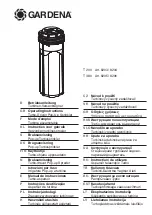
9
Step 4.
Open the filter inlet valve. Flush the sanitizing solution through the sampling
valve.
Note
: The filter will not achieve 100% removal of bacteria. If you do not have downstream
chlorine injection bacteria may colonize in the piping downstream of the filter and the storage
tank. Periodic sanitizing of the piping and storage tank will address this problem.
7
System Start-Up
Step 1.
Open the inlet valve to the filtered water storage tank and continue filtering water.
Step 2.
Adjust the low-level float switch in the filtered water storage tank. The low level
float switch should be set such that the water level does not go below the storage tank
outlet. The mechanical float should be set such that the water level does not go above the
storage tank overflow. Adjust the high-level float switch in the filtered water storage tank.
The high-level float switch should be set at a level just below the mechanical float valve.
Step 3.
Prime the distribution pump, following the pump manufacturer’s instructions.
Step 4.
Plug the pump electrical outlet into the storage tank low level switch in a
piggyback fashion, and plug into the wall outlet. Test the pump by moving the lower float
switch. The pump should operate when the switch is moved to the ‘up’ position.
Step 5.
Water should continue to run through the system until the water level in the
filtered water storage tank is just below the overflow. The high-level float switch should
close the solenoid valve and allow the filter to drain to the "paused" water level. The
mechanical float valve will stop the flow of water if the high-level float switch is out of
adjustment. Adjust the mechanical float valve and high-level float switch as required.
Check the system for plumbing leaks and repair as required.
8
Operation
Note
: In cases where extremely turbid water is being treated, it may be necessary to
perform filter maintenance immediately following installation.
Step 1.
The system is operational once the filter flow rate has been set, water has
been flushed through the filter and the standpipe has been sanitized.
Step 2.
Ensure the anti-siphoning valve is fully open during normal operation.
Step 3.
To test the system, turn on a water source, such as a bath tap. The pump
should start up and draw water from the storage tank.
Step 4.
Continue the water demand until you are sure the system is functioning well
and all mechanical floats and storage tank level switches are adjusted as specified.
Step 5.
Your BioSand Filter system is now up & running. During normal operation, the flow
rate will decrease as the filter accumulates sediment on the top layer of sand. Once an
acceptable flow rate cannot be maintained, it will be necessary to perform maintenance on
the filter.

































